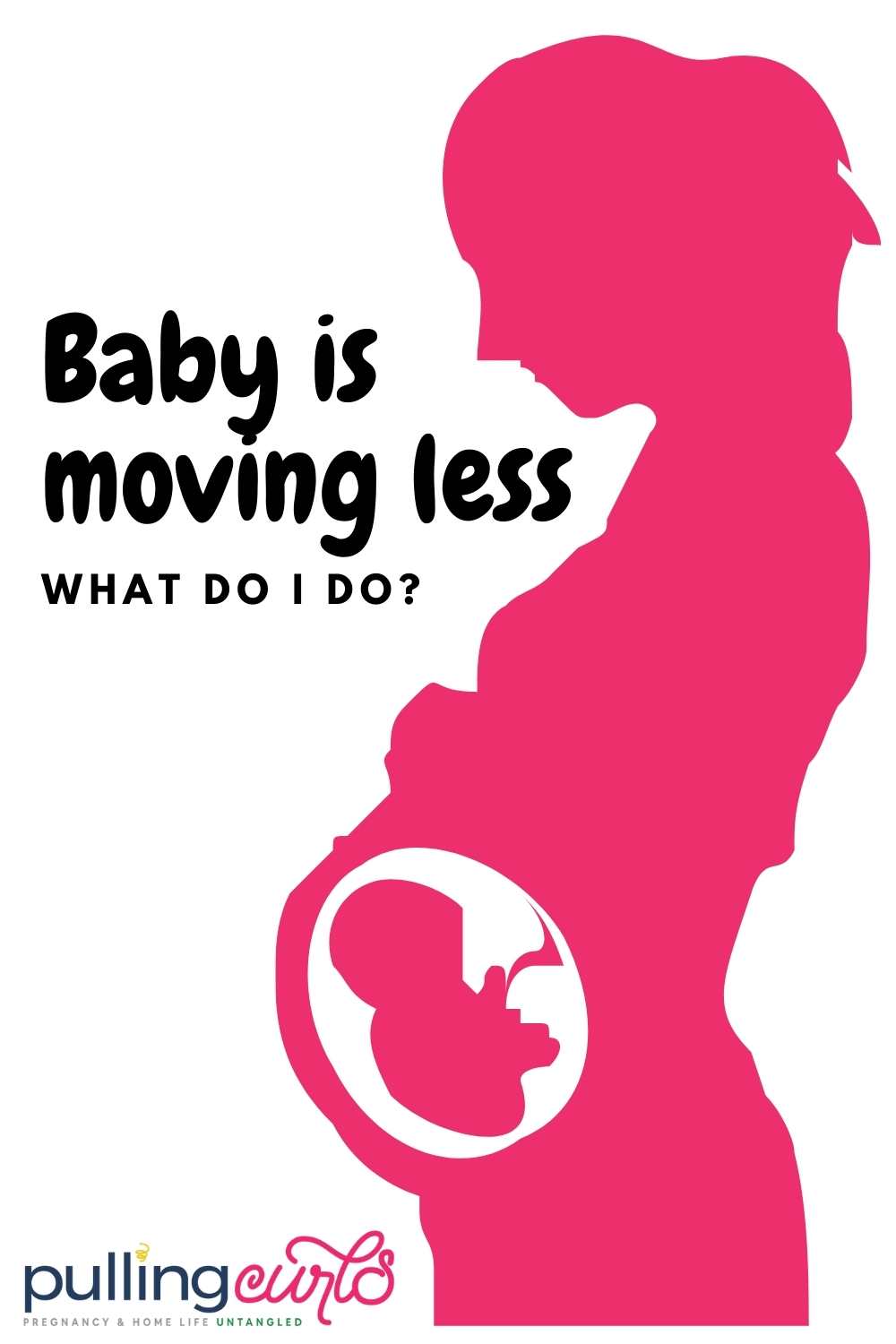In this post we will learn what decreased fetal movement is and how you can use kick counts to be aware of your baby’s movements as well as when to go to L&D for kick counts taking longer. Did you know that tracking baby’s movements help your baby arrive safe and sound — something so simple!

I am seeing so many monitors, devices, and gadgets coming out to make your pregnancy safer. The cost a lot of money. And you know what most of them are doing — counting fetal movement or baby’s kicks. And the beautiful money-saving thing that God gave you is an ability to count your baby’s own movements.
Problem is, we all get so busy and people don’t know how to do it or expectant parents worry they’re doing it wrong. But honestly, it’s not that hard — you’re just feeling the baby move.
It’ss truly the best way to know how your baby is doing from home! Plus, you can bond with your sweet babe and even have a good time getting to know them before you can see/hold them. 🙂
Before we get any further, let me introduce myself.
First off, hello! I’m Hilary — many people know me as The Pregnancy Nurse 👩⚕️. I have been a nurse since 1997 and I have 20 years of OB nursing experience, I am also the curly head behind this website Pulling Curls and The Online Prenatal Class for Couples. 🩺 I’ve seen thousands of patients who have felt decreased movement and I take EACH one of them seriously, and so should you.
If you haven’t felt your baby move today, baby isn’t moving as much or there is reduced fetal movement I would always call my provider or head into labor and delivery. Fetal movement is the best indicator of fetal well being for a pregnant person. Please take it seriously. Your doctor or midwife sure will. Obviously, don’t take any of the information in this article as medical advice. We’re just a nice read.
I am so passionate about knowing your baby’s habits, I actually did a podcast about kick counts where I explained how it all works, and why you should do them. It’s not long — take a listen:
Pro Tip: This information is for your third trimester, if you’re looking for information on baby’s movement in your lower abdomen at 20 weeks << check out that post.
I also have a kick count cheat sheet you should download:
When to go to hospital for decreased fetal movement?
If you are truly feeling no/hardly any movement you should either go to the hospital or call your doctor right away. While you’re doing that I would encourage you to quickly eat a snack that has some carbs and protein and also a BIG glass of ice water to see if baby is just napping.
Fetal movement is complicated though, so let’s talk about it.
Understanding how to stay stafe in those last few weeks of pregnancy is SO important. I have a whole lesson on it in here!
Decreased Fetal Movement
We have plenty of people come to our hospital for “decreased fetal movement” — which basically means you feel the baby less frequently than you did before.
Honestly, it always makes me nervous when patients say that — because I believe that you’re not feeling baby move and that could be a serious issue.
For the majority of the women, the baby is fine. Things are fine and for some reason the baby had less activity. I feel a lot of gratitude when I find the baby’s heart rate.
Reasons for Decreased Fetal Movement
- You haven’t drunk much water lately. Your baby needs buckets and buckets of water. You’re drinking for two. Drink up (I have a whole post on if Gatorade is safe in pregnancy too)
- You haven’t eaten much. We frequently get patients who haven’t eaten for much of the day and yet – -their baby isn’t moving. Well, GOSH — no wonder – -you’re starving them! EAT!
- Further along in your pregnancy. Around 30 weeks you’ll have a karate ninja warrior in your belly, and then little by little the movements will get smaller and less ferocious. Your mom alarms might go off, just because things are different. BUT, less movement (or less intense movements) are normal at this time. BUT it should just be little by little (due to there being less room), not a drastic change.
- And, of course, less fetal movement can happen if something is wrong — which is WHY you pay close attention to fetal movement.
I also have a whole post on if you’re having increased fetal movement, if it means labor is near. I also have a post if you’re 30 weeks and movement seem less.
What does it mean if baby hasn’t moved all day?
It could mean you’re busy or baby is just having more “gentle” movements as they get more packed into the uterus. But, if baby isn’t moving you need to be seen ASAP. Call your provider on your way into the hospital as you eat something and drink some water.
Baby Kick counts taking longer
Maybe you’re doing your kick counts, but they’re taking longer than usual. If it’s just a bit longer than usual than just wait. but if it’s a LOT longer than usual I’d recommend heading into the hospital.
These are some good tips any time of day you’re feeling less movement:
- Drink a giant glass of ice water. When the cold water is next to your baby’s home it transfers to the baby and they often give a WTH and move around a bit to get warm. 🙂
- Eat something. Preferably something with a little sugar as that will raise your blood sugar the fastest. Some fruit is a great option (if you’re not diabetic)
- Feel. We get so busy with our day and our other kids that we often really haven’t taken the time to notice. So, lay down (on your side or sit up — pregnant women shouldn’t lay flat on their backs), drink your water, eat your fruit and just feel.
- If you’re still not feeling anything, call your doctor.
Keep in mind that babies routine sleep cycles. So, your baby moving less for a half hour to an hour is totally normal. Heck, I know you’ll want them to sleep once they’re out!
Fetal Movement Count
Kick counts are a way to daily assess your baby’s fetal movement. The process is very similar to what I outlined above. It is good to start with those first 3 steps. But, then you’re waiting to feel the number of kicks (you want to see how long it takes to get to 10). You can either count baby’s kicks on your fingers (that’s the simple way!), use an app or use a paper to track them. If it takes more than a 2-hour period to get 10 kicks you need to call your doctor. Or, if you’ve done it for a while and the movement has REALLY changed (normally, you get them in 10 minutes, but this time it was an hour) call your healthcare provider.
So, here is your VERY simple guide to kick counts:
- Make a note of the time you start.
- See how long it takes to get 10 movements — jot that # down.
That’s mostly it. Many think they’re counting the number of times they kick, but you’re counting the TIME PERIOD instead. You’ll notice that there is a usual amount of time it takes (and that number will fluctuate the further along you get in your pregnancy). You’ll have a daily record of how baby is doing.
BTW, if you love simple instructions like this, you’ll love my prenatal class. Check it out here!
Looking to get prepare for your birth? I have some easy options for you!
~~~~~~~~
– Worried you’re missing something? Grab my pregnancy planner so you don’t miss a thing!
– Thinking about an induction? Grab Inductions Made Easy to feel prepared in just 20 minutes!
– Wondering how to get that baby OUT? Grab Going Into Labor Made Easy so you know how to (and not to) do it!
– Postpartum got you anxious? Check out Postpartum Care Made Easy so you can stay SAFE even when all your attention is on that little on.
🚨 AND if ALL OF IT has got you on edge The Online Prenatal Class for Couples is perfect for you — You’ll feel so ready before you even know it!
~~~~~~~~
No matter WHERE you are at in your pregnancy journey, we have resources that can help!
Fetal Kick Counts
A few tips:
Kick counts should be started in your third trimester (so, around 28 weeks – if you sign up for my weekly pregnancy newsletter, I’ll remind you!). Of course, even if you’re second trimester you can feel and get an idea of what’s normal (but you won’t get the consistancy you’ll need til’ closer to 28 weeks gestation). During that last trimester of your pregnancy, these matter and are most easily done.
Any movement counts for a kick count. Feel a flutter, shift, turn or a tiny jab. That counts. You don’t have to SEE the movement to count it. Hiccups don’t count (those are like rhythmic “bounces” from your baby). It is true that how much fetal movement you feel is dependent on your abdominal wall (larger girls tend to feel less than skinny girls), your placenta location (an anterior placenta can “muffle” the kicks a bit) and baby positioning. But ANY of baby’s kicks count (big or small).
I liked to do mine after dinner (in the evening hours) and, sadly, that left my husband to clean up the dinner (and I laid on the couch). It was a time I could be without kids and responsibilities (and I often needed a little break at this point). Poor husband.… 🙁 Doing it at a similar time of day really helps.
Get in a comfortable position. Most women find that laying on their left side helps (but every mom & baby is different).
By doing them daily, at the same time of the day — you really get a good gauge of what’s normal with your baby. You’ll be able to tell more when something is off.
Kaiser was OBSESSED with Kick counts (I had my last 2 kids at a Kaiser hospital), which I thought was weird, until I started to read up on them. They truly are the best way to tell the baby’s well-being. And so cheap. Natural and awesome. In fact, since you have 10 fingers, the most common way is to use those!
While the amount of time REALLY varies (due to a variety of reasons), the amount of time most people find doing their fetal movement counting it will take 15-30 minutes to get those 10 movements.
And, first time moms might find these a little bit harder in the beginning than moms who’ve done them before.
When to go to the Hospital for Decreased Fetal Movement
If you don’t do kick counts, the rule of thumb has been 2 hours (but some people don’t feel their baby move every two hours, so take that into consideration as well.
If kick counts are taking double their usual time I’d call my provider. If you’re not feeling ANYTHING in your regular timeframe I’d just go into labor and delivery.
There are studies that show that most stillbirth mothers felt the baby was moving less in the last week. That means that often the stillbirth doesn’t happen for a while, but baby is showing signs by moving less.
The beauty of kick counts, is you start to notice patterns, or a baseline number it usually takes. Sure, baby might be asleep for 30 minutes, but then they wake-up and you get your 10 movements fairly quickly.
Movements within the womb will change over time. Knowing your baby’s movement patterns will serve you well.
When your baby is small they will like little karate experts, jabbing you all over the place.
As they grow larger, and their living space is more compact, they don’t make as sharp/quick movements. That all happens gradually over days.
If you notice a significant changes in movements, that’s the most important thing — I’d call your doctor and see what they recommend. It could be a sign of a problem (or, it could just be baby sleeping, etc).
As I mentioned before, make sure you’re eating and drinking (water) regularly — as that can really affect the baby’s movements patterns as well (and keep your unborn baby happy).
And yes, in chapter two of The Online Prenatal Class for Couples we go through most of the reasons you might need to either call your doctor or head into L&D — so don’t miss out on that too!
Benefits of Kick Counts
There are many benefits to kick counts — beyond just baby safety
It gives you a gauge of if you’re taking care of yourself — so many women come to L&D after not eating or drinking. Those are easy problems YOU can solve, and when you do kick counts it gives you a bit of time to assess how you’re doing at taking care of yourself. 🙂
You can bond with a baby you can’t see. As you spend this time with your baby, you’ll notice more things. You’ll really get to knowbaby’s movement patterns and you’ll have time to think and dream about motherhood and how much you love something you’ve never really seen. It’s really such a special time. 🙂
It gives you the latest information. It’s always handy to have specific #’s that you can give to your providers when you are feeling like there could be an issue.
It assures your baby’s safety. Kick counting — as we’ve said, are a great way to make sure baby is doing well. I know you want nothing more than a healthy baby — and kick counts are something YOU can do to stay on that path!
There is a movement in the US to really bring attention to kick counts that I am really passionate about.
Since the 2009 launch of Count the Kicks in Iowa, the stillbirth rate in Iowa has been reduced by 26 percent! TWENTY SIX PERCENT. I couldn’t believe that. That’s one in four stillbirths that we’d be able to save!!!
I want to state categorically that I’m not being paid by then to write this post, but because I am REALLY passionate about saving babies lives. I want to challenge everyone reading this article to please share it with your pregnant friends.
Who knows what baby YOU could save!
My manager actually shared this movement with me after meeting with the author of this amazing article. I feel so warm and fuzzy when people pivot their grief into something really positive. I’m really excited you’re reading this!
So, normally at this point I’d tell you to join my newsletter (which you still should) but I really want you to go on your favorite social media channel and SHARE the importance of kick counts. I know a lot of OB’s don’t share them in their office. I am not sure why. I guess they might sound old-fashionedand that they don’t really work. But they do. Please share this.
I recommend doing it after you’ve eaten and drank a good amount of water (I liked to do mine after dinner)
There will be some fluctuation — especially in the first few days you do it, but you should be able to gauge what’s normal for your baby (especially if timing, having eaten and other things are staying the same). And the first time you do it will be different than the 30th time you do it.
Some do, some don’t. I say do them, for sure! If you have questions, ask your medical provider, for sure!
Honestly, I say no. This is a time for you to just sit and think about your baby and your future. Take some time out and feel that baby!
YES! Even if you’re having non-stress tests, biophysical profile or other testing you should still do kick counts daily! It’s good for you and baby (btw, I have a whole thing on 3rd trimester testing here) — especially important if you have risk factors!
YES! As you get towards the end of pregnancy this becomes more and more important!
Yes, things like high blood pressure can be problematic for baby — so expectant mothers with issues make sure to do them to monitor baby’s health.
It really depends on YOUR baby. Depending on baby’s position, the position of the placenta and your abdomen your baby may move a lot less than other people’s. The question is if it’s a lot longer than it normally is for your baby you need tog et seen.
If your baby’s movement is very different from their normal movement lately (not two weeks ago, what’s normal for the last week or so) then yes. I’d call your provider or head into the hospital.
If baby is truly just not moving today I’d head into the hospital. I’d eat something on the way and get some ice water too. I’d also call my health care provider on the way.
Yes! Everything counts as a kick — all movements, except for hiccups.
Hiccups are a systemic reaction due to growing lungs and diaphragm. It doesn’t show that baby is making the choice to shift and move in the womb. It’s almost like the hiccups are being done to them rather than them just moving.
Because there isn’t a reliable pattern of fetal movement we don’t start kick counts until your third trimester, so — somewhere between 27 and 28 weeks of pregnancy. At 25 weeks if baby is moving less you may want to still call your provider. I have a whole post on when to start kick counts.
Many anterior placenta moms don’t feel baby move much at all. Some say that they don’t feel 10 movements in an hour ever. Talk with your doctor about what’s best to do for you in regards to kick counts in this case. Remember, what’s “normal” is what’s normal for you — so even anterior placenta moms know if things are different.
This can be normal as baby gets more tightly-packed into the uterus during pregnancy, and the amount of fluid around them may be less. However, this should change over time — not karate kicks one day, and only tiny shifts the next day. That’s why daily kick counts are so important — to see the daily changes.
While there are some things that can make baby move a lot, most often baby moving a lot is just them growing in the womb. If you feel like your baby is moving too much mention it to your doctor though. They may want to make sure things are normal. Any time you feel a significant change in fetal movement you should call your provider.
Kick counts are still your best indicator of baby’s well-being. Most often you don’t the heart rate long enough with home dopplers (or at-home ultrasounds) to tell if there is an issue they might catch at the hospital with continuous fetal mointoring.
Sometimes babies take a LONG time to move. If that is the case, it’s a good idea to talk with your provider and see what they want to do.
I’ve heard this isn’t usual as your constant movement during the day rocks baby to sleep.
If you want to learn more about ultrasound testing I have a podcast all about it with a high risk stonographer:
I have a whole post on when to go to labor and delivery too that you might find helpful.
Ok, if you’ve gotten this far, you are clearly READY to have your confident birth — check out this Online Prenatal Class for Couples. Remember, it comes in 3 price points, and can be done in just 3 hours…. it’s pretty great!
Not sure we’re a good fit check out my free class — It’s your first step towards being your own birth boss.














Cassie says
This information is really inappropriate and not in with the most evidence based practice.
Women should not be told that after 30 weeks it is normal for baby’s to move less sometimes. I would urge you to rethink this post
Hilary Erickson says
Ummm…. it is normal for the moved to be less. That’s why I recommend women. Do it daily. Gradual trends of less “hard” moves (which most people translate into “moving less”) helps women know how their baby is doing vs a once and a while check in.
kelly monahan says
No it’s not inappropriate…it’s actually right on the mark. I’m a labor and delivery nurse of 20+ years and couldn’t have said it better myself. This is such an important life saving measure that momma’s can do for the sweet babes in their bellies (and their own peace of mind). Thanks for bringing this issue up and spreading the word.
Hilary Erickson says
Thanks for coming to my defense! I agree!
Tayyba says
My first baby was still born and my delivery is on 25 December 2018
Now I am again pregnant on 25 April 2019 kindly guide me more on this
Hilary Erickson says
Oh my goodness, I am so sorry to hear about your stillborn…. that is really hard. 🙁 Sure I can guide you! Sign up for my pregnancy newsletter post — and I’ll give you awesome tips for just how far along you are.